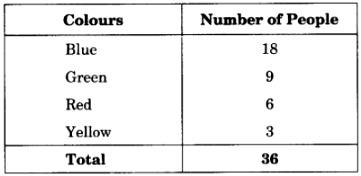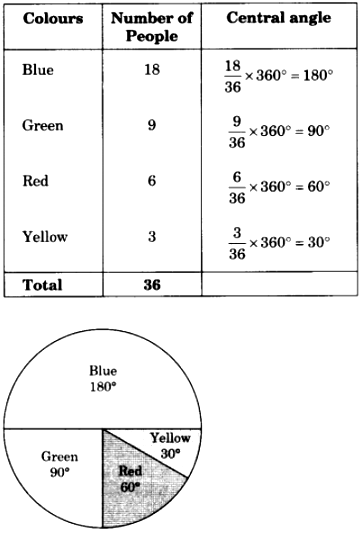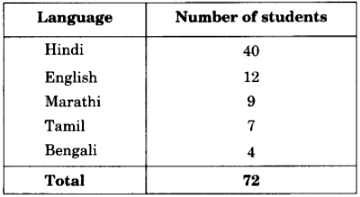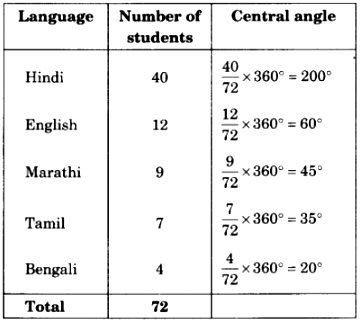8. Draw a pie chart showing the following information. The table shows the colours preferred by a group of people.

Solution:
Table to find the central angle of each sector

9. The following pie chart gives the marks scored in an examination by a student in Hindi, English, Mathematics, Social Science and Science. If the total marks obtained by the students were 540, answer the following questions.

(i) In which subject did the student score 105 marks?
(Hint: for 540 marks, the central angle = 360°. So, for 105 marks, what is the central angle?)
(ii) How many more marks were obtained by the student in Mathematics than in Hindi?
(iii) Examine whether the sum of the marks obtained in Social Science and Mathematics is more than that in Science and Hindi.
(Hint: Just study the central angles).
Solution:

(i) For 540 marks, the central angle = 360°
For 105 marks the central angle = \(\frac{360}{540}\times 105\) = 70°
Corresponding subject = Hindi
(ii) Marks obtained in Mathematics = \(\frac{90}{360}\times 540\) = 135
Marks obtained in Mathematics more than Hindi = 135 – 105 = 30
(iii) Central angle of Social Science + Mathematics = 65° + 90° = 155°
Central angle of Science + Hindi = 80° + 70° = 150°
Marks obtained in Social Science and Mathematics are more than that of the marks obtained in Science and Hindi.
10. The number of students in a hostel, speaking different languages is given below. Display the data in a pie chart.

Solution:


11. List the outcomes you can see in these experiments.
(a) Spinning a wheel
(b) Tossing two coins together

Solution:
(a) There are four letters A, B, C and D in a spinning wheel. So there are 4 outcomes.
(b) When two coins are tossed together. There are four possible outcomes HH, HT, TH, TT.
12. When a die is thrown, list the outcomes of an event of getting
(i) (a) a prime number (b) not a prime number.
(ii) (a) a number greater than 5 (b) a number not greater than 5.
Solution:
(i) (a) Outcomes of event of getting a prime number are 2, 3 and 5.
(b) Outcomes of event of not getting a prime number are 1, 4 and 6.
(ii) (a) Outcomes of event of getting a number greater than 5 is 6.
(b) Outcomes of event of not getting a number greater than 5 are 1, 2, 3, 4 and 5.
13. Find the.
(a) Probability of the pointer stopping on D in (Question 11-(a)).
(b) Probability of getting an ace from a well shuffled deck of 52 playing cards.
(c) Probability of getting a red apple. (See figure below)

Solution:
(a) In a spinning wheel, there are five pointers A, A, B, C, D. So there are five
outcomes. Pointer stops at D which is one outcome.
So the probability of the pointer stopping on D = 1/5
(b) There are 4 aces in a deck of 52 playing cards. So there are four events of getting an ace.
So, probability of getting an ace = 4/52 = 1/13
(c) Total number of apples = 7
Number of red apples = 4
Probability of getting red apple = 4/7
14. Numbers 1 to 10 are written on ten separate slips (one number on one slip), kept in a box and mixed well. One slip is chosen from the box without looking into it. What is the probability of .
(i) getting a number 6?
(ii) getting a number less than 6?
(iii) getting a number greater than 6?
(iv) getting a 1-digit number?
Solution:
(i) Outcome of getting a number 6 from ten separate slips is one.
∴ probability of getting a number 6 = 1/10
(ii) Numbers less than 6 are 1, 2, 3, 4 and 5 which are five. So there are 5 outcomes.
∴ probability of getting a number less 6 = 5/10 = 1/2
(iii) Number greater than 6 out of ten that are 7, 8, 9, 10. So there are 4 possible outcomes.
∴ probability of getting a number greater than 6 = 4/10 = 2/5
(iv) One digit numbers are 1, 2, 3, 4, 5, 6, 7, 8, 9 out of ten.
∴ probability of getting a 1-digit number = 9/10
15. If you have a spinning wheel with 3 green sectors, 1 blue sector and 1 red sector, what is the probability of getting a green sector? What is the probability of getting a non-blue sector?
Solution:
A total of five sectors are present.
Out of the five sectors, three sectors are green.
∴ probability of getting a green sector = 3/5
Out of the five sectors, one sector is blue. Hence, Non-blue sectors = 5 – 1 = 4 sectors
∴ probability of getting a non-blue sector = 4/5
16. Find the probabilities of the events given in Question 12.
Solution:
When a die is thrown, there are total six outcomes, i.e., 1, 2, 3, 4, 5 and 6.
(i)
(a) 2, 3, 5 are the prime numbers. So there are 3 outcomes out of 6.
∴ probability of getting a prime number = 3/6 = 1/2
(b) 1, 4, 6 are not the prime numbers. So there are 3 outcomes out of 6.
∴ probability of getting a prime number = 3/6 = 1/2
(ii)
(a) Only 6 is greater than 5.
So there is one outcome out of 6.
∴ probability of getting a number greater than 5 = 1/6
(b) Numbers not greater than 5 are 1, 2, 3, 4 and 5. So there are 5 outcomes out of 6.
∴ probability of not getting a number greater than 5 = 5/6